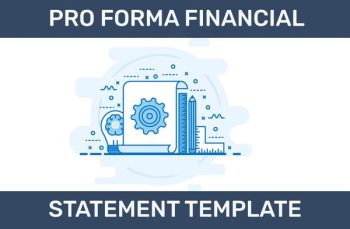- Strategies to Overcome Common Challenges with Zero Based Budgeting
- An Effortless Plan to Make a Zero-Based Budgeting
- How to Use Technology to Automate Your Zero Based Budget
- How to Calculate the Valuation of a Startup
- Understand the Benefits of Activity Based Budgeting
We have designed 450+ Financial Model Templates Designed in Excel or Google Sheet for different companies which are ready to use and you just need to type the inputs in the yellow cells and you will get the desired financial model. You can also check E-Commerce Financial Model Templates , Food and Beverage Financial Model Templates , Retail Financial Model Templates.
After reading this article, you should be able to learn:
- What are pro forma financial statements?
- Types of pro forma financial statements
- How to prepare pro forma financial statements?
- Common uses of pro forma financial statements
- Limitations of pro forma financial statements
- FREQUENTLY ASKED QUESTIONS
What are pro forma financial statements?
Pro forma financial statements are prepared by an organization based on certain underlying assumptions or assumptions about events that have occurred in the past or are expected to occur in the future. These financial reports present the financial results of the company to stakeholders, investors of an investment proposal or to guarantee the finances of lenders.
The budget statements prepared by the company for the next financial year can be considered as pro-forma financial statements which depict the financial projection of the company based on assumptions.
These finances are generally prepared and presented with financial statements prepared according to international accounting standards. Typically, these statements are indented to gain the confidence of investors and lenders to secure finances by showing them the impact of adjustments.
Like general purpose financial statements prepared in accordance with Generally Accepted Accounting Principle (GAAP) or International Financial Reporting Standards (IFRS) or other applicable reporting frameworks, Proforma Financial Statements include:
- Proforma income statement
- Property balance sheets
- Proforma cash flow statement
IMPORTANT POINT: Read our separate articles on the Income Statement, Balance Sheet and Cash Flow Account. You can also check the free Monthly Income Statement, Annual Income Statement, Monthly Balance Sheet & Annual Balance Sheet and Cash Flow Dashboard . where you just need to put your numbers in yellow cells and see the financial analysis with well-built graphs.
Types of pro forma financial statements
Here are the common types of pro forma financial statements differentiated based on the intended purpose of the financial statements:
- Annual pro-forma projection: The results of the year to date and the expected results for the remaining financial end are added to the current results of the year old in the form of Proforma financial statements. This type of FORMAL FINANCIAL is used by management for internal reviews and can be presented to investors and financiers.
- Investment or Funding Projection: When an organization is considering additional investment or funding to expand its operations, this program is used to show the projected results of the injection of additional funding/capital to the business. The impact of additional financing by shareholders or lenders is presented in this Proforma Statement for potential investors to gain confidence.
- Historical with Acquisition: This type of Proforma statement is prepared by consolidating the historical financial statements of the target company that the organization intends to acquire with its own historical financial statements to analyze the impact of the acquisition.
- Risk Analysis: To assess the financial impact of various business scenarios, the business manager uses these Proforma financial statements to develop a strategy to mitigate the impact in the event the worst case scenarios occur.
How to prepare pro forma financial statements
Proforma financial statements are prepared using the following steps:
- Identify your sources of income for the calculation of projected income. These projections will be based on certain assumptions such as target market, percentage market share, expected growth and other assumptions.
- Identify the direct cost of generating revenue such as production cost, selling and administrative costs, payroll cost, interest charges, taxes, etc.
- The company’s non-current assets and those that were to be acquired either using equity financing or loans from investors and financial institutions. Current assets have accumulated due to income generation and business operations.
- Calculate your current and non-current liabilities based on incurred costs related to business operations and asset accumulations.
- Pro forma income statement will be prepared by combining the projected revenues and the costs incurred to generate such revenues.
Download monthly income statement in Excel
- Pro forma balance sheet is prepared by recording assets, liabilities and equity in the proforma model.
Download the monthly balance sheet in Excel
- Pro Forma Pro Forma is prepared by recording cash flows and outflows, movement in current assets and current liabilities.
Download a Monthly Cash Flow Statement in Excel
Common uses of pro forma financial statements
Proforma financial statements are used as a planning and control tool by organization. The intended use of Proforma financial statements depends on the requirement of business owners and manager, the different uses of Proforma statements are explained as follows:
- Business leaders and owners use Proforma financial statements for annual budgeting, planning, and long-term decision making. Budget statements which are a type of financial statement in the format are an effective tool to monitor business performance and steer its operations in the right direction while taking corrective action in a timely manner.
- Investors use FORFORMA financiers to assess potential investments and expected returns while evaluating projected results. The reliability of projected results depends on the reality of the assumptions used by management. In the event that the results presented by the company are based on a realistic hypothesis, the investor can gain confidence in financing the operations of the companies or its expansion projects.
- Business leaders use to strategize to mitigate the impact of any potential changes in its business operation and overall business climate. In the event that a company anticipates changes in its supplier relationships, increased prices for its supplies and other adverse scenarios, its financial impact could be incorporated to assess alternative options and mitigate the risk of adverse scenarios before ‘they don’t happen.
- Organizations use such a statement while obtaining loans or additional capital from a business partner or shareholder.
Limitations of pro forma financial statements
Although Proforma financial statements are widely used by businesses as an effective planning and decision-making tool, there are some limitations of these Proforma financial statements.
Some of the limitations are presented as follows:
- The pro forma financial statements contain hypothetical amounts and estimates, however, these assumptions and estimates cannot realistically be realized. In the event that the underlying assumptions did not work as intended by management; The business may face challenges.
- These statements are not prepared in accordance with generally accepted accounting principles (GAAP) and may not necessarily include information that is relevant, prominent and reflects the actual operations of the company.
- Adjustments are made to pro-forma financial statements such as the impact of non-recurring expenses such as written assets or the financial impact of foreign currency fluctuations, which is outside of the main business activities of the organization.
- There are no standard guidelines or framework followed when preparing program financial statements rather companies use their own freedom when preparing the projection, exclude and include events that may not truly reflect performance of the company.
- Some organizations take an aggressive approach to discretionary adjustments and projection of financial results from Proforma statements, eliminating expenses that are sometimes integral to doing business, such as legal costs, acquisition expenses, and the cost of stock/share-based compensation
FREQUENTLY ASKED QUESTIONS
Q. Why do we exclude transactions and events from the Proforma financial statements?
A. To arrive at actual core business operations and business activities, we often exclude certain transactions and events that are unusual and non-recurring such as restructuring expenses, legal fees, etc.
Q. How to ensure the reliability of Proforma financial statements which are generally considered misleading?
A. To gain stakeholder confidence in the formats’ financial statements, the company must ensure that it uses realistic and true assumptions representative of prevailing market conditions.
Q. Are these financial formats prepared under GAAP or any other standard framework?
A. No, these Proforma financial statements are not prepared in accordance with GAAP or any other applicable financial reporting framework.
Q. Why does the company prepare Proforma financial statements when statements are prepared under GAAP?
A. Generally, these financial forms are prepared in addition to financial statements prepared under GAAP to represent a true picture of the company’s financial performance that management is not truly represented by GAAP-based financial statements.
[right_ad_blog]




